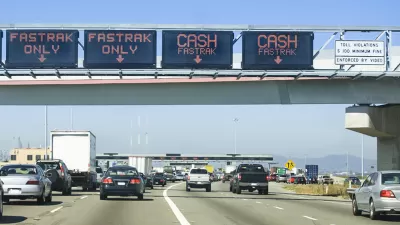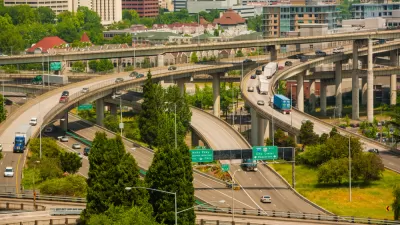Comprehensive road pricing through tolls and congestion charges could play a major role in reducing housing prices and sprawl, according to a new study.
"An elaborate modeling of housing prices and traffic congestion in cities across the US concludes that financing roads with comprehensive congestion priced tolls rather than taxes rather would provide major benefits in reducing housing prices and sub-optimal densities - 'sprawl' - as well as reducing the familiar delays and uncertain travel times. Moving to tolls or other direct road use charges will significantly improve overall welfare, economic efficiency and standards of living, the study says. Authors are Ashley Langer University of California Berkeley and Clifford Winston, Brookings Institution. The study is reported in Brookings-Wharton Papers on Urban Affairs 2008.
It's a complex work. The methodology attempts to model the effects of congestion pricing on home location decisions, home prices and density. It allows for changes in land use and density, but sets limits to density permitted. Existing congestion conditions in various metro areas are fed into the model, and an array of different values of time saved provided for. The model differs from earlier ones in that it allows for that heterogeneity of values of time saved rather than assuming people are the same and using an average.
The model allows for the fact people will sort into commute distances inversely with their value of time, so different people will react differently to congestion pricing and gain different benefits.
The overall effect of comprehensive road pricing managed for free flow is likely to be decreased housing prices, higher density living especially in middle suburbs. Pricing encourages people to live somewhat closer to their work."
FULL STORY: Urban tolls would reduce cost of housing, provide major social benefits study shows

Manufactured Crisis: Losing the Nation’s Largest Source of Unsubsidized Affordable Housing
Manufactured housing communities have long been an affordable housing option for millions of people living in the U.S., but that affordability is disappearing rapidly. How did we get here?

Americans May Be Stuck — But Why?
Americans are moving a lot less than they once did, and that is a problem. While Yoni Applebaum, in his highly-publicized article Stuck, gets the reasons badly wrong, it's still important to ask: why are we moving so much less than before?

Using Old Oil and Gas Wells for Green Energy Storage
Penn State researchers have found that repurposing abandoned oil and gas wells for geothermal-assisted compressed-air energy storage can boost efficiency, reduce environmental risks, and support clean energy and job transitions.

Greening Oakland’s School Grounds
With help from community partners like the Trust for Public Land, Oakland Unified School District is turning barren, asphalt-covered schoolyards into vibrant, green spaces that support outdoor learning, play, and student well-being.

California Governor Suspends CEQA Reviews for Utilities in Fire Areas
Utility restoration efforts in areas affected by the January wildfires in Los Angeles will be exempt from environmental regulations to speed up the rebuilding of essential infrastructure.

Native American Communities Prepare to Lead on Environmental Stewardship
In the face of federal threats to public lands and conservation efforts, indigenous groups continue to model nature-centered conservation efforts.
Urban Design for Planners 1: Software Tools
This six-course series explores essential urban design concepts using open source software and equips planners with the tools they need to participate fully in the urban design process.
Planning for Universal Design
Learn the tools for implementing Universal Design in planning regulations.
Heyer Gruel & Associates PA
City of Moreno Valley
Institute for Housing and Urban Development Studies (IHS)
City of Grandview
Harvard GSD Executive Education
Salt Lake City
NYU Wagner Graduate School of Public Service
City of Cambridge, Maryland





























